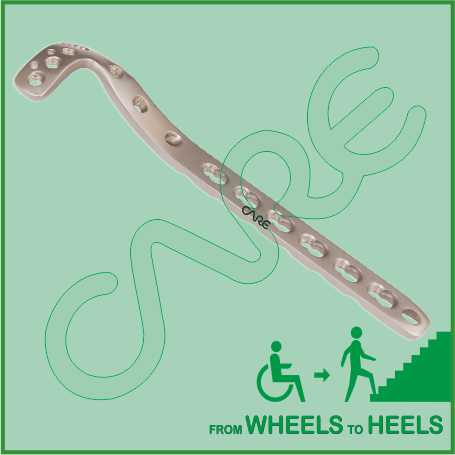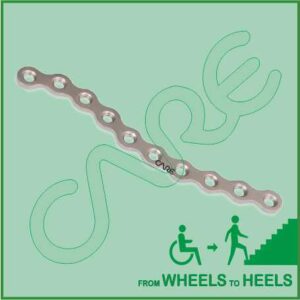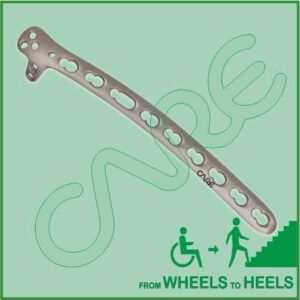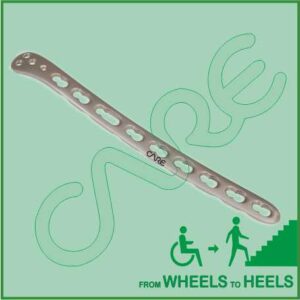Description
| Ref. No. Ti | Ref. No. SS | Position | Size | Ref. No. Ti | Ref. No. SS | Position | Size |
| LCP667704
LCP667706 LCP667708 LCP667710 LCP667712 LCP667714 LCP667716 |
BQ-004R
BQ-006R BQ-008R BQ-010R BQ-012R BQ-014R BQ-016R |
Right
Right Right Right Right Right Right |
4H
6H 8H 10H 12H 14H 16H |
LCP667804
LCP667806 LCP667808 LCP667810 LCP667812 LCP667814 LCP667816 |
BQ-004L
BQ-006L BQ-008L BQ-010L BQ-012L BQ-014L BQ-016L |
Left
Left Left Left Left Left Left |
4H
6H 8H 10H 12H 14H 16H |
3.5 mm Locking Plate Proximal Tibia, Right/Left Specification
- Plates available holes are 4, 5, 6, 7, 8, 9, 10, 12, 14 and 16.
- Plates available for Left and Right both direction
- Plate has combi holes and round holes. Combi holes allow fixation with locking screws in the threaded section and cortex screws in the dynamic compression unit section for compression.
- Four convergent threaded screw holes accept 3.5 mm Locking Screws and 3.5 mm Cortical Screws.
- The three locking holes distal to the plate head accept 3.5 mm Locking Screws or 3.5 mm Cortical Screw to secure plate position. The hole angles allow the locking screws to converge with three of the four locking screws in the plate head to support medial fragments.
- The shaft holes accept 3.5 mm locking screws in the threaded portion or 3.5 mm cortical screws or 4 mm cancellous screws in the compression portion.
- Three 2 mm holes for preliminary fixation with Kirschner wires, or meniscal repair with sutures.
- Anatomically contoured to match the lateral proximal tibia.
- 3.5 mm Locking Plate Proximal Tibia, Right/Left allow implant placement to address the individual fracture pattern.
- Limited-contact surface reduces bone-to-plate contact and helps to preserve the periosteal blood supply.
- Choice of different lengths of plate eliminates the need to cut plates.
- Pre-contoured plate to match anatomical shape.
- Available in both Titanium and Stainless steel.
- locking plate increases construct stability, decreases risk of screw back-out and subsequent loss of reduction. It also reduces the need for precise anatomic plate contouring and minimizes the risk of stripped screw holes.
- A complete Instruments Set is available for 3.5 mm Locking Plate Proximal Tibia, Right/Left. General Instruments are available for this plate such as Plate Bending Press, Plate Holding Forceps, Plate Bending Pliers, Bone Holding Forceps, Bone Elevators, Bone Cutter, Bone Nibbler, Depth Gauge, Sleeve, Screw Driver, Trocar Sleeve etc.
3.5 mm Locking Plate Proximal Tibia, Right/Left Uses
3.5 mm Locking Plate Proximal Tibia, Right/Left are indicated for temporary internal fixation and stabilization of osteotomies and fractures, including:
- Comminuted fractures
- Supracondylar fractures
- Intra-articular and extra-articular condylar fractures
- Fractures in osteopenic bone
- Nonunions
- Malunions
3.5 mm Locking Plate Proximal Tibia, Right/Left Contraindications
Contraindications may be qualified or total, and need to be taken into consideration when evaluating the prognosis in each case. Alternative management techniques may need to be considered under the following conditions:
- Acute or chronic infections, either local or systemic.
- Local or systemic accurate or chronic inflammation.
- Serve muscular, nervous or vascular disease endangering the affected area.
- Defective bone structures, which would impede adequate anchoring of the implant.
- All associated diseases which could endanger the function and success of the implant.
Warnings and Precautionary for 3.5 mm Locking Plate Proximal Tibia, Right/Left
Before using 3.5 mm Locking Plate Proximal Tibia, Right/Left, the surgeon and ancillary staff should study the safety information in these instructions, as well as any product-specific information in the product description, surgical procedures and/or brochures.
Plates are made from medical grade materials and are designed, constructed and produced with utmost care. These quality assure best working results provided they are used in the proper manner. Therefore, the following instructions for use and safety recommendations must be observed.
Improper use of Plates can lead to damage to the tissue, premature wear, destruction of the instruments and injury to the operator, patients or other persons.
It is vital for the operating surgeon to take an active role in the medical management of their patients. The surgeon should thoroughly understand all aspects of the surgical procedure and instruments including their limitations. Care in appropriate selection and proper use of surgical instruments is the responsibility of the surgeon and the surgical team. Adequate surgical training should be completed before use of 3.5 mm Locking Plate Proximal Tibia, Right/Left.
Factors which could impair the success of the operation:
- Allergies to implanted materials.
- Localized bone tumours.
- Osteoporosis or osteomalacia.
- System disease and metabolic disturbances.
- Alcohol and drug abuse.
- Physical activities involving excessive shocks, whereby the implant is exposed to blows and/or excessive loading.
- Patients who are mentally unable to understand and comply with the doctor’s instructions.
- Poor general health.
Possible Adverse Effects
The following adverse effects are the most common resulting from implantation:
- Loosening of the 3.5 mm Locking Plate Proximal Tibia, Right/Left, which may result from cyclic loading of the fixation site and/or tissue reaction of the implant.
- Early and late infection.
- Further bone fracture resulting from unusual stress or weakened bone substance.
- Temporary or chronic neural damage resulting from pressure or hematomata.
- Wound hematomas and delayed wound healing.
- Vascular disease including venal thrombosis, pulmonary embolism and cardiac arrest.
- Heterotopic ossification.
- Pain and discomfort due to presence of the Implants.
- Mechanical failure of the implant, including bending, loosening or breakage.
- Migration of implant resulting in injury.
Preoperative Planning for 3.5 mm Locking Plate Proximal Tibia, Right/Left
The operating planning is carried out following a thorough clinical evaluation of the patient, Also, x-rays must be taken to allow a clear indication of the bony anatomy and associated deformities. At the time of the operation, the corresponding implantation instruments in addition to a complete set of 3.5 mm Locking Plate Proximal Tibia, Right/Left must be available.
The clinician should discuss with the patient the possible risks and complications associated with the use of Implants. It is important to determine pre-operatively whether the patient is allergic to any of the implant materials. Also, the patient needs to be informed that the performance of the device cannot be guaranteed as complications can affect the life expectancy of the device.
3.5 mm Locking Plate Proximal Tibia, Right/Left Precautions
- Confirm functionality of instruments and check for wear during reprocessing. Replace worn or damaged instruments prior to use.
- It is recommended to use the instruments identified for this screw.
- Handle devices with care and dispose worn bone cutting instruments in a sharps container.
- Always irrigate and apply suction for removal of debris potentially generated during implantation or removal.
3.5 mm Locking Proximal Tibia Plates Warnings
- 3.5 mm Locking Plate Proximal Tibia, Right/Left can break during use (when subjected to excessive forces). While the surgeon must make the final decision on removal of the broken part based on associated risk in doing so, we recommend that whenever possible and practical for the individual patient, the broken part should be removed. Be aware that implants are not as strong as native bone. Implants subjected to substantial loads may fail.
- Instruments, screws and cut plates may have sharp edges or moving joints that may pinch or tear user’s glove or skin.
- Take care to remove all fragments that are not fixated during the surgery.
- While the surgeon must make the final decision on implant removal, we recommend that whenever possible and practical for the individual patient, fixation devices should be removed once their service as an aid to healing is accomplished. Implant removal should be followed by adequate post-operative management to avoid refracture.
3.5 mm Locking Plate Proximal Tibia, Right/Left General Adverse Events
As with all major surgical procedures, risks, side effects and adverse events can occur. While many possible reactions may occur, some of the most common include: Problems resulting from anesthesia and patient positioning (e.g. nausea, vomiting, dental injuries, neurological impairments, etc.), thrombosis, embolism, infection, nerve and/or tooth root damage or injury of other critical structures including blood vessels, excessive bleeding, damage to soft tissues incl. swelling, abnormal scar formation, functional impairment of the musculoskeletal system, pain, discomfort or abnormal sensation due to the presence of the device, allergy or hypersensitivity reactions, side effects associated with hardware prominence, loosening, bending, or breakage of the device, mal-union, non-union or delayed union which may lead to breakage of the implant, reoperation.
 CARE IMPLANTS & INSTRUMENTS
CARE IMPLANTS & INSTRUMENTS





